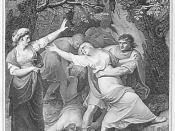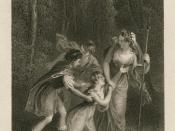Dynamic Violence
The Creation and Undermining of Dichotomies in Titus Andronicus
1. Introduction
Titus Andronicus has, for a long time, been one of Shakespeare's most poorly regarded plays, notably for the violence and brutality with which it is filled. Indeed, the play belongs to the genre of revenge tragedies and features numerous murders, mutilations, decapitations and a rape (or two, depending on how you count). Once the cycle of revenge has been initiated, vicious plots, evil deeds and numerous deaths follow until all who were involved in the initial wrong that had been done have suffered or died. Julie Taymor, director of the 1999 film Titus, even claimed that she had never "seen any dissertation on violence as complete as Titus" (Schechner 46). While it was "popular in Shakespeare's day largely as a sensationalistic and visceral piece" (LaBlanc)�, and has seen a few periods of popularity, it has also been criticised extensively and has "experienced long periods of neglect" (Metz 154).
T. S. Eliot, for example, called it "one of the stupidest and most uninspired plays ever written" (67). Recently, however, the play has gained more attention and been valued more highly; it has actually "begun to seem more worthy of scholarly critical attention" (Sanderson 498). With the emergence of feminist and ethnic studies, the questions of gender and race in Titus Andronicus have been addressed through analyses of the characters of, for example, Titus' daughter Lavinia and Aaron the Moor. Yet the play offers more material for analyses than merely racial and gender issues.
A structuralist analysis of what has often been termed Shakespeare's bloodiest play will reveal that there are numerous dichotomies, or binary oppositions, to be found in it. As poststructuralists such as Jacques Derrida have pointed out, binary opposites are normally hierarchised, which is to say...


